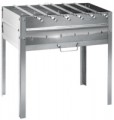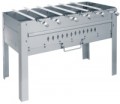Design
-
Collapsible. This category includes barbecues and other devices that are disassembled into separate parts for transportation - accordingly, when installed in a working position, these parts must be assembled back. They are less convenient to disassemble and assemble than folding ones, but are much more compact.
—
Folding. Folding devices include devices whose design, when folded into a stowed position, does not disassemble into parts, but folds. However, it may also contain removable parts, but the structure itself is foldable. The specific layout of such models can be different: a stand in the shape of the letter X, in the upper part of which a box for coals is placed (or the structure itself plays the role of such a box), a suitcase that can be opened and installed on the stand, etc.
-
Stationary. The stationary design does not require disassembly and is designed for “home” use. On the other hand, the absence of restrictions on portability has made it possible to make such models very advanced: they can have a large height, which will eliminate the need for the user to bend over, high power and capacity, and an abundance of additional features. And many models have a pair of wheels that allow you to transport the grill, say, from a barn to a “field kitchen.”
—
Built-in. Devices designed to be built into a k
...itchen unit, countertop, etc. and do not require self-installation. In fact, they are a special variety of the stationary models described above: they do not imply “traveling” use and frequent movements from place to place, even if the product is installed on a cart with wheels. In addition, most devices in this category are gas grills (see “Fuel (source)”), which can be permanently connected to the gas line. In any case, a built-in device can be a good option when equipping a stationary barbecue area - in the yard under a canopy, in the kitchen of a cafe/restaurant, etc.
— Tabletop. A rather rare design, found mainly among barbecue grills with a gas or electric heater (see “Fuel”). Such models are small in size, which allows you to place the device on any suitable table or move it from place to place without additional steps (without disassembling or folding). At the same time, such devices are not suitable for use outdoors; their main purpose is the courtyard of a private house, or even an ordinary kitchen. Many tabletop devices are almost indistinguishable from kitchen electric grills.Wall thickness
The thickness of the furnace walls.
This parameter is relevant primarily for solid fuel models (see “Fuel (source)”), and its general meaning directly depends on the type of product (see above), more precisely, on the material of the furnace. So, for barbecues, charcoal grills and other devices with metal fireboxes, the overall reliability and durability of the structure depends primarily on the wall thickness. At the same time, a value of up to 1 mm is considered very limited; it can be found mainly in low-cost models designed for occasional use. 1 – 2 mm can be called an average, and a thickness of 3 mm or more is already suitable for intensive daily use.
In turn, in ceramic grills and tandoors, the wall thickness is already measured in tens of millimetres; in the first case, it is usually about 18 – 20 mm, in the second — from 50 mm and more. Both there and there, thick walls serve to effectively accumulate and retain heat; accordingly, the greater the thickness, the better the product handles with these tasks.
Anyway, note that thicker (and, accordingly, more reliable and efficient) walls inevitably turn out to be heavier and more expensive.
Height
Product height in working position.
If there is no cover or canopy in the design or delivery set (see “Functions and Capabilities”), then the total height, usually, corresponds to the height of the grate, seats for skewers or other work surface. If there is a cover or canopy, then the height is given according to the overall size of the structure, and it usually does not correspond to the actual height of the working surface; the latter should be specified according to the manufacturer's documentation. However, when it comes to the lid, this difference is usually not particularly critical; but the canopy is usually located at a considerable height (comparable to the height of a person, or even noticeably greater).
In general, a height of
50 cm or less is considered relatively small,
50 – 100 cm — medium,
more than 100 cm — significant. However, when choosing a particular product, it is worth considering both the nuances described above and other features. For example, if you are looking for a portable brazier for hiking "forays" into nature, it makes sense to pay attention to low and, accordingly, light and compact models. And for professional use, when you have to “stand over cooking” often and for a long time, higher models are better suited, which you don’t have to bend over to check readiness, turn skewers, etc.
Dimensions (WxD)
Dimensions of the product deployed to the working position, in length and width; for round models, both of these dimensions are also indicated, just in such cases they are usually the same (equal to the diameter).
The general meaning of this characteristic is as follows: a larger product (with the same shape and type) usually has a larger capacity, but it turns out to be more bulky (including when folded, if such a possibility is provided), heavy and expensive. Moreover, in many cases, the overall dimensions in length and width correspond to the size of the working surface; a classic example is the traditional rectangular brazier, as well as many barbecue grills of the same shape. So if the data on the working surface (see below) are not separately indicated in the characteristics, then it may well be that the size of the brazier is equal to the overall dimensions (or differs very slightly from them). For a full guarantee in such cases, you should pay attention to the photographs of the product: if there are no shelves or other similar elements in the design that affect the length and width, then these dimensions can be used to estimate the dimensions of the working surface (that is, the total capacity and other related nuances ). For example, in the case of a traditional brazier, the width of the firebox determines the minimum length of the skewer (the skewer should be slightly longer to cover the firebox when installed across); and the number of places for skewers...directly depends on the length of the barbecue (ideally, there should be at least 60 mm between these places). If the dimensions of the working surface are given in the characteristics, then it is worth evaluating the practical capabilities of the product according to these dimensions; the overall dimensions in such cases only allow us to estimate the amount of space occupied by this model.
Also note that the height of the structure in the characteristics is indicated separately — in this case it has a different meaning than the length and width.

